Shani G. Radiation Dosimetry: Instrumentation and Methods
Подождите немного. Документ загружается.

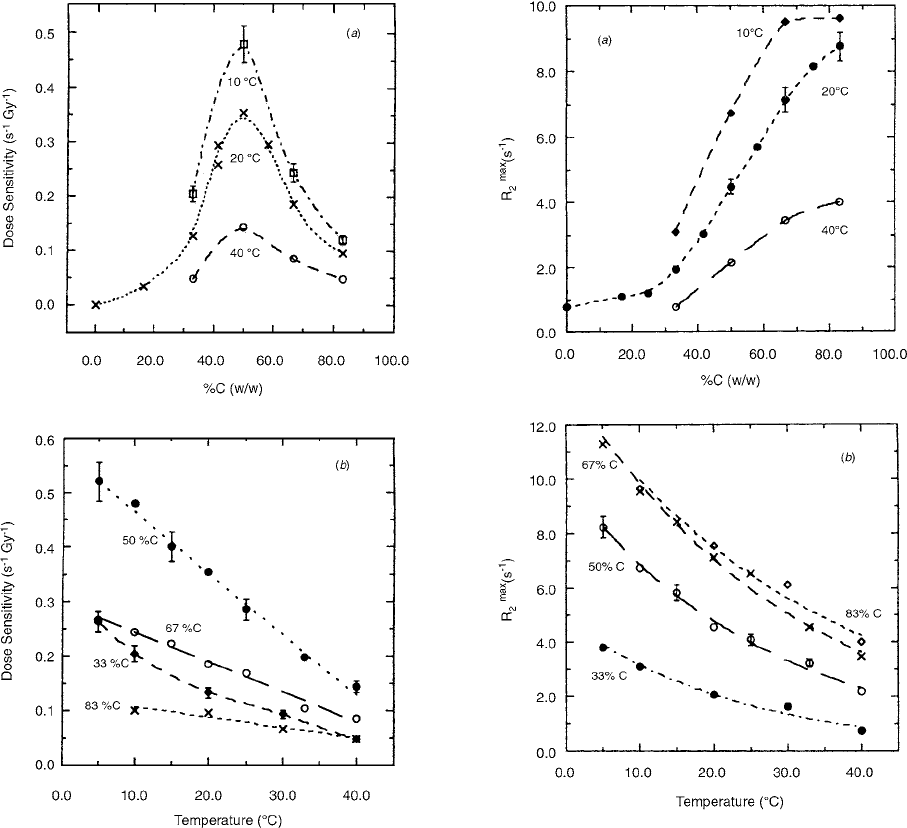
420 Radiation Dosimetry: Instrumentation and Methods
Figure 9.23a shows the effect of varying the cross-
linker fraction on , the maximum R
2
achievable by a
saturation dose, at three different temperatures. It can be
seen that increases with cross-linking and that this
dependence increases dramatically above approximately
30%C. In addition, this effect is clearly enhanced by cool-
ing the gels during the NMR measurment.
Figure 9.23b illustrates the dependence of on
temperature for several different values of cross-linker
fraction. appears to be more sensitive to temperature
changes as the cross-linker fraction increases.
Figure 9.24 shows how the dose-response curve for a
50%C BANG gel changes with temperature. It is clear that
it is the radiation-induced build-up of the cross-linked
polyacrylamide in the gel that enhances the solvent R
2 ,
as
well as rendering it more sensitive to temperature changes.
The spatial uniformity of gel sensitivity to radiation
was found to depend strongly on the presence of oxygen,
which must be eliminated for the gel dosimeter to be of
use. The gel formula used by Oldham et al. [21] is shown
in Table 9.3.
The 3D gel-image data produced by the NMR scanner
is in the form of calculated T
2
relaxation times. This image
must be converted to absorbed dose to allow verification
of radiotherapy dose distributions. Conversion is achieved
by means of a calibration curve, obtained by measuring
FIGURE 9.22 (a) Dependence of the initial dose-response sen-
sitivity on the cross-linker content for three different temperatures
at which
R
2
was measured. (b) Dependence of the dose sensitivity
on the measurement temperature for several different proportions
of the cross-linker. (From Reference [20]. With permission.)
R
2
max
R
2
max
R
2
max
R
2
max
FIGURE 9.23 (a) Dependence of the maximum R
2
measured at
a saturation dose on cross-linker fraction for three dif-
ferent temperatures. (b) Dependence of on temperature for
several different values of cross-linker fraction. (From Reference
[20]. With permission.)
R
2
max
()
R
2
max
Ch-09.fm Page 420 Friday, November 10, 2000 12:04 PM
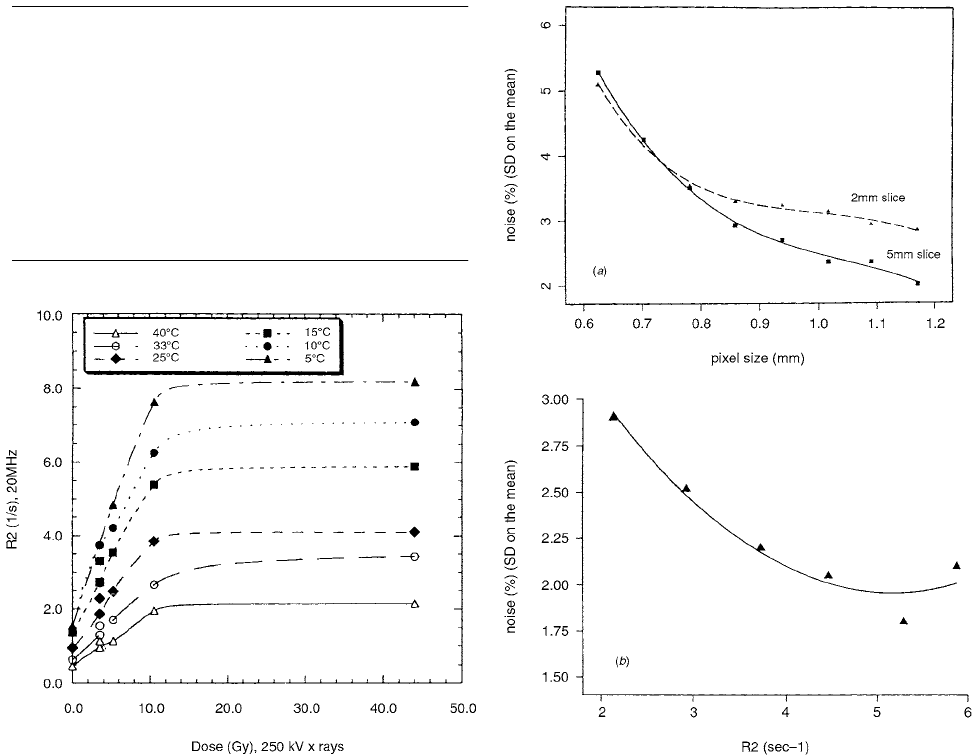
Gel Dosimetry 421
the T
2
relaxivity in regions of the gel that have been irra-
diated to known doses.
The final step in forming the calibration curve was to
determine the dose actually delivered in the regions of
interest for which the T
2
values were measured. This deter-
mination was performed by film measurement in a simu-
lated geometry. The required quantity is D
m
, the absorbed
dose delivered by a 2 2-cm
2
, 6-MV radiation field to
the measurement plane after it has been attenuated through
a 6-mm Perspex plate and a 2-cm layer of gel. D
m
was
calculated according to
(9.26)
where D
m
is the dose in the measurement plane; MU is
the number of monitor units delivered; D
f
is the dose per
MU measured by a piece of film placed in a Perspex
sandwich at the effective radiological path length (d) to
the measurement plane (
d 2.38 cm is the Perspex-equiv-
alent radiological path length of 6 mm of Perspex and 2 cm
of gel); ISC is an inverse-square law correction to allow for
the fact that the measurement plane is 2 mm further from the
source than the film; and BSC is a backscatter correction to
account for the reduced backscatter radiation from the nitro-
gen space compared with solid Perspex. The ISC term is
(102.38102.6)
2
0.9957. The BSC term for a 2- 2-cm
2
field, from Perspex that is 2 cm from the measurement
plane, is negligible and was ignored.
Figure 9.25a shows the relationship between the stan-
dard deviation (SD) in a 1-cm-diameter region placed cen-
trally in the irradiated region and the pixel size. It is seen
that for a 2-mm slice thickness, little improvement in noise
TABLE 9.3
Chemical Composition of BANG–gel
Component Formula Weight Fraction Amol
Gelatin C
17
H
32
N
5
O
6
0.05 402.22
Acrylamide CH
2
CHCONH
2
0.06 71.04
Bis (CH
2
CHCONH)
2
CH
2
0.06 154.1
Water H
2
O 0.83 18
From Reference [21]. With permission.
FIGURE 9.24 Effect of temperature on the R
2
dose-response
curve of the 50%C BANG. (From Reference [20]. With permis-
sion.)
D
m
MU D
f
ISC BSC()
FIGURE 9.25 (a) The relationship between noise (i.e., stan-
dard deviation on the mean) in small regions (
1 cm
2
) in the
T
2
(or R
2
1/T
2
) gel image and the pixel size. (b) The rela-
tionship between noise (i.e., standard deviation on the mean)
in the
T
2
(or R
2
1/T
2
) gel image and R
2
. High R
2
corresponds
to high dose and high polymerization. (From Reference [21].
With permission.)
Ch-09.fm Page 421 Friday, November 10, 2000 12:04 PM
422 Radiation Dosimetry: Instrumentation and Methods
is gained by increasing the pixel size above 0.8
0.8 mm
2
. The latter therefore represents a good tradeoff
between noise and spatial resolution. Figure 9.25b shows
the relationship between noise (SD on the mean) and R
2
.
The MR-imaging sequence parameters were chosen to
minimize the errors for fitting the exponential decay of
short T
2
(i.e., high-dose regions 6–8 Gy, corresponding
to an R
2
of 5–6.0).
REFERENCES
1. Gore, J. C. et al., Phys. Med. Biol., 29, 1189, 1984.
2.
Schreiner, L. J., in Proc. 1st International Workshop
on Radiation Therapy Gel Dosimetry,
1999, 1.
3.
Appleby, A., in Proc. 1st International Workshop on
Radiation Therapy Gel Dosimetry,
1999, 9.
4.
Audet, C., in Proc. 1st International Workshop on Radi-
ation Therapy Gel Dosimetry,
1999, 31.
5.
Back, S. A. J. and Olsson, L. E., in Proc. 1st Interna-
tional Workshop on Radiation Therapy Gel Dosimetry,
1999, 47.
6.
Maryanski, M. J., in Proc. 1st International Workshop
on Radiation Therapy Gel Dosimetry,
1999, 63.
7.
Maryanski, M. J. et al., Phys. Med. Biol., 39, 1437,
1994.
8.
Gore, J. C. et al., Phys. Med. Biol., 41, 2695, 1996.
9.
Maryanski, M. J. et al., Med. Phys., 23, 699, 1996.
10.
Gambarini, G. et al., Phys. Med. Biol., 39, 703,
1994.
11.
Balcom, B. J. et al., Phys. Med. Biol., 40, 1665, 1995.
12.
Luciani, A. M. et al., Phys. Med. Biol., 41, 509, 1996.
13.
Olsson, L. E. et al., Phys. Med. Biol., 37, 2243, 1992.
14.
Schulz, R. J. et al., Phys. Med. Biol., 35, 1611, 1990.
15.
Gambarini, G. et al., Nucl. Inst. Meth., A422, 643, 1999.
16.
Gambarini, G. et al., Rad. Prot. Dos., 70, 571, 1997.
17.
Kelly, R. G. et al., Med. Phys., 25, 1741, 1998.
18.
Bero, M. A. et al., Nucl. Inst. Meth., A422, 617, 1999.
19.
Maryanski, M. J. et al., Phys. Med. Biol., 41, 2705,
1996.
20.
Maryanski, M. J. et al., Phys. Med. Biol., 42, 303,
1997.
21.
Oldham, M. et al., Phys. Med. Biol., 43, 1113, 1998.
22.
Parasad, P. V., Rad. Res., 128, 1, 1991.
Ch-09.fm Page 422 Friday, November 10, 2000 12:04 PM

423
10
Neutron Dosimetry
CONTENTS
I. Introduction ............................................................................................................................................................423
II. Kerma Calculation and Measurement....................................................................................................................425
III. Gas-Filled Neutron Dosimeters .............................................................................................................................436
IV. TLD Neutron Dosimetry........................................................................................................................................446
V. Superheated Drop Neutron Dosimeter...................................................................................................................451
VI. Solid-State Neutron Dosimeter ..............................................................................................................................460
VII. Bonner Sphere and Other Portable Neutron Monitors..........................................................................................466
References .......................................................................................................................................................................476
I. INTRODUCTION
Neutrons are non-ionizing particles and are thus identified
by detection of ionizing particles emitted in neutron interac-
tion. The most common reactions are (
n
,
), (
n
,
p
), (
n
,
),
and proton recoil.The dosimeters can be gas-filled, scintilla-
tors, TLD, solid-state, track detectors, photographic film, and
other types. Gas-filled neutron dosimeters are generally tis-
sue-equivalent ionization chambers. The properties required
for a neutron dosimeter are high efficiency for neutron detec-
tion, constant response per unit kerma in tissue as a function
of neutron energy, and the possibility to discriminate against
-radiation. It is important that the dose or the energy trans-
ferred to the dosimeter is similar to that transferred to the
human body irradiated, taking into consideration the body
composition, such as bone, tissue, etc.
Neutron dosimetry is done for medical purposes as well
as in nuclear research laboratories, reactor centers, nuclear
power stations, and industry. For routine radiation surveys,
the “rem-counters” have practically solved the problem of
measuring dose-equivalent rates without much information
on neutron spectra. Routine personnel neutron dosimetry is
done by TLD badges and pocket ionization chambers. The
requirements for accident dosimetry are different from those
for routine survey and dosimetry. Superheated drop detectors
are useful for environment dosimetry.
Most neutron dosimeters that exist for direct reading or
quick, easy evaluation are of the military or civil defense
type, such as tissue-equivalent condenser chambers, neutron-
sensitive diodes, or radiation elements, suitable for foolproof
operation. Accident dosimetry for neutrons is well-estab-
lished. The important systems are reliable critical alarms and
similar dosimetry systems that are partly worn by persons
and partly set up on fixed positions in the controlled areas.
Fission-track dosimeters and activation-threshold detectors,
together with body counting for
24
Na by a simple body
counter, permit a reasonable quick evaluation of the severity
of exposures after an accident.
Standardization of neutron dosimetry procedures has
been established by drafting protocols for neutron dosim-
etry for radio therapy in Europe and the U.S. The use of
calibrated tissue-equivalent (TE) ionization chambers with
TE gas filling is recommended as the practical method for
obtaining the tissue kerma in air and the absorbed dose in
a TE phantom. The TE chamber should have a calibration
factor for photons applied to it.
Correction factors convert the reading of the chamber to
the charge produced in an ideal chamber at a reference tem-
perature and pressure. Also, correction factors account for
the finite size of the TE chamber, its build-up cap, and its
stem when measurements are made in air. For the conversion
of measured charge to absorbed dose, several parameters are
necessary, including the average energy required to create an
ion pair in the gas, the gas-to-wall absorbed dose conversion
factor, the neutron kerma ratio of reference tissue to that in
the wall material of the ionization chamber, and the displace-
ment correction factor.
The types of personnel neutron dosimeters commonly
used for radiation-protection purposes are neutron film type
A (NTA film), thermoluminescent albedo dosimeters
(TLD albedo), superheated drop detectors, and fission
track detectors. Deficient energy response and sensitivity,
fading, use of radioactive material, and other limitations
prevent any of these dosimeters from being satisfactory
for universal application in a wide variety of radiation
environments.
A primary requirement for the personnel neutron
dosimetry system is that it be able to meet current regulatory
Ch-10.fm Page 423 Friday, November 10, 2000 12:04 PM
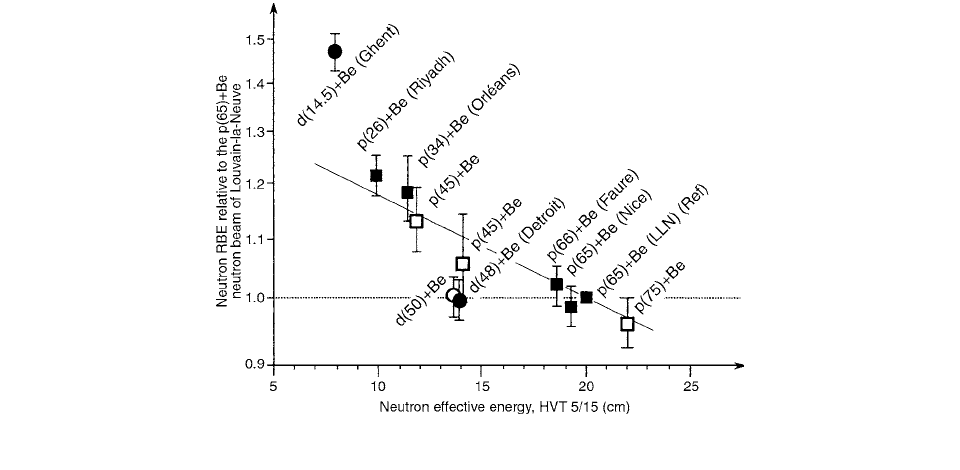
424
Radiation Dosimetry: Instrumentation and Methods
requirements. Neutron dosimeters should be worn if the
neutron whole-body dose equivalent exceeds 10% of the
- plus X-ray dose equivalent. The dosimeter is consid-
ered satisfactory for operation in mixed radiation fields
if it can measure 1 rem of fast neutrons in the presence
of 3 rem of
-rays with energy above 500 keV. The
dosimeter response must simulate the dose-equivalent
conversion factor, which varies by a factor of 40 over
that range. Radiation weighting factor is given below
for various kinds of radiation and for neutrons of various
energies.
Calculation of the radiation weighting factor for neu-
trons requires a continuous function; the following
approximation can be used, where
E
is the neutron energy
in MeV:
(10.1)
The rationale for fast neutron therapy (high LET radi-
ation) is based on radiobiological arguments: [1]
a. a reduction in the oxygen enhancement ratio
(OER) with high LET radiations; i.e., a selec-
tive efficiency against hypoxic cancer cells;
b. a greater selective efficiency against cells in the
most radio-resistant phases of the mitotic
cycle;
c. a smaller role of the sub-lethal lesions; i.e., less
importance of the dose per fraction.
These factors can bring an advantage or a disadvantage,
depending on the characteristics of the cancer cell popu-
lation and of the normal tissues at risk. This raises the
problem of patient selection. According to NCI, fast neu-
tron therapy should be the treatment of choice for
advanced-stage salivary gland tumors, and surgery should
be limited to cases where there is a high likelihood of
achieving a negative surgical margin and where the risk
of facial nerve damage is high.
A standard A-150 tissue-equivalent or graphite thim-
ble chamber having a standard
60
Co calibration factor is
the recommended reference dosimeter for clinical proton
dosimetry. The mean neutron energy or related parame-
ters such as the half-value thickness (HVT) have also
been used (Figure 10.1). The development of the micro-
dosimetric programs has shown that this approach is
indeed an oversimplification and that several types of
secondary charged particles must be taken into account
(Figure 10.2).
In a given neutron beam, the RBE does not vary as a
function of depth (Figure 10.2). For proton beams, the
observed RBEs are lower, ranging from about 1.0 to 1.2.
This range is clinically significant but only slightly larger
than the experiment uncertainties on RBE determinations
(Figure 10.3). The proton energy decreases with depth
and, thus, there is possible increase in RBE.
Type and energy range of radiation Radiation weighting
factor
Photons, all energies 1
Electrons and muons, all energies * 1
Neutrons, energy
10 keV 5
10 keV to 100 keV 10
100 keV to 2 MeV 20
2 MeV to 20 MeV 10
20 MeV 5
Protons, other than recoil protons, energy
2 MeV 5
Alpha particles, fission fragments, heavy nuclei 20
* Excluding Auger electrons emitted from nuclei to DNA, for which
special microdosimetric considerations apply.
W
R
W
R
W
R
517e
2E()ln()
2
6
---
FIGURE 10.1
Variation of RBE on different neutron beams as a function of energy. (From Reference [1]. With permission.)
Ch-10.fm Page 424 Friday, November 10, 2000 12:04 PM
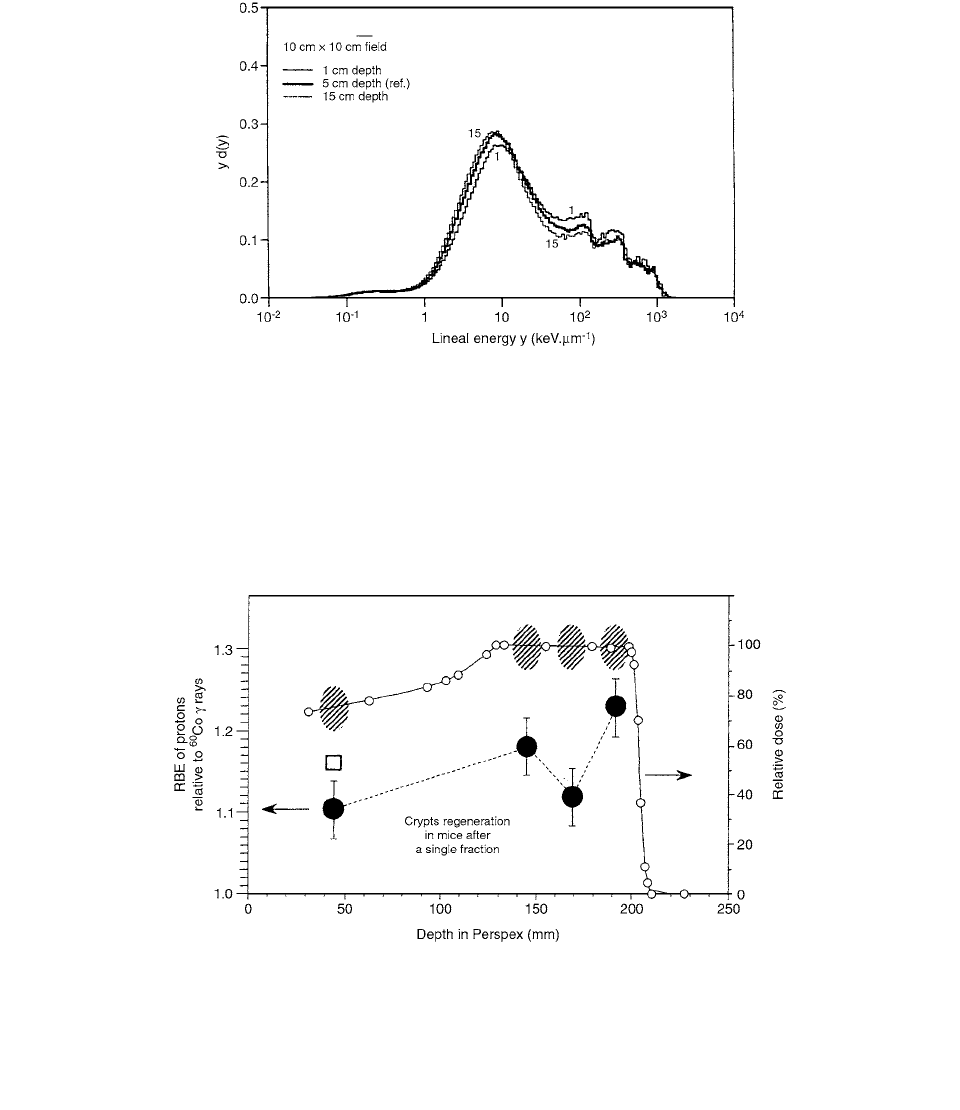
Neutron Dosimetry
425
II. KERMA CALCULATION AND
MEASUREMENT
Kerma is defined as the average kinetic energy released
in matter (per unit mass) and is the sum of all energy
transferred to light-charged particles and residual nuclei
in a reaction. The neutron kerma factor is the kerma pro-
duced per unit neutron fluence. The absorbed dose is the
energy deposited per unit mass.
Neutron dose is obtained by calculating the kerma.
The kerma factor for neutrons of energy , for a given
material is defined as the ratio of the neutron kerma
K
and
the neutron fluence. The kerma factor is usually calculated
from the average energy transferred to kinetic energy of
FIGURE 10.2
Comparison of microdosimetric spectra measured at different depths in a phantom on the beam axis of the
p
(65)
Be neutron therapy beam of Louvain-la-Neuve (the highest energy used in neutron therapy). The curves represent the distributions
of individual energy deposition events in a simulated volume of tissue 2
m in diameter. The parameter
y
(lineal energy) represents
the energy deposited by a single charged particle traversing the sphere, divided by the mean cord length. Four peaks can be identified
in the
p
(65)
Be neutron spectra: the first is at 8 keV
m
1
and corresponds to high-energy protons, the second is at 100 keV
m
1
and corresponds to low-energy protons, the third is at 300 keV
m
1
and is due to a-particles, and the last is at 700 keV
m
1
and is due to recoil nuclei. The (rather flat) peak corresponding to the gamma component of the beam is at 0.3 keV
m
1
.
The differences between the spectra measured at differents depths are relatively small and no significant RBE variation has been
detected. (From Reference [1]. With permission.)
FIGURE 10.3.
Variation of RBE with depth in the modulated 200-MeV proton beam produced at the National Accelerator Centre
(NAC), Faure (left ordinate, closed circles). The width of the spread-out Bragg peak is 7 cm (from 13 to 20 cm in depth). The error
bars indicate the 95% confidence intervals. The open square corresponds to the RBE for the unmodulated beam. The depth-dose
curve in the modulated beam is superimposed for comparison (right ordinate, small open circles). The hatched areas indicate the
different positions where the mice were irradiated. The width of the shaded areas corresponds to the size of the mice abdomens.
(From reference [1]. With permission.)
k
f
E
n
Ch-10.fm Page 425 Friday, November 10, 2000 12:04 PM

426
Radiation Dosimetry: Instrumentation and Methods
charged particles in the various types of interactions and
the corresponding cross sections. For neutron energy
less than 20 MeV, the data can be taken from the
ENDF/B-V data file. For higher energies, the data is from
relied-on calculations only. Above 15 MeV the number of
nuclear reactions increases and substantially contributes
to the kerma, with strong uncertainty in the cross section.
Erroneous cross sections due to the use of inadequate
calculation models, in particular for light elements, leads
to large discrepancies in kerma factor calculations. More
experimental data are needed at energies above 20 MeV.
The kerma factor can be obtained by direct
dose measurement with ionization chamber or propor-
tional counter. Knowing the dose, the kerma
K
, and
the fluence provides the necessary data. A-150 tissue-
equivalent plastic and graphite chambers are used for
this purpose.
The energy transferred (kerma per neutron per cm
3
)
for an incident neutron of energy
E
in the laboratory is
defined by
(10.2)
where
i
identifies the element,
j
identifies the type of
nuclear reaction, is the number of nuclei of the
i
th
element per gram, and is the average amount of
energy transferred to kinetic energy of charged particles
in a collision whose cross section is . For elastic
scattering, the kinetic energy (laboratory system) of a
recoiling nucleus of mass
A
relative to that of the neutron
is
(10.3)
where is the angle of scattering of the neutron in the
center of mass system.
For inelastic scattering the energy transferred to a
recoil nucleus left in an excited state with energy above
the ground is
(10.4)
The kerma can be calculated by
(10.5)
where
j
is the secondary particle type produced by the
neutron interaction,
E
is the particle energy, and is
the intensity of the particle spectrum (particles per gram
per neutron per cm
2
).
W
is given by
(10.6)
For elastic scattering, if the neutron fluence intensity is
and the atomic density in the material is
N
(atoms/g), the differential spectrum intensity of the recoil-
ing particle of mass
A
and energy is
(10.7)
The neutron mass is assumed to be unity, (cos )
is a Legendre polynomial of degree
l
, and is its coef-
ficient. In the case of elastic scattering by hydrogen,
(10.8)
where
and
The total kerma induced by neutrons in the wall mate-
rial of the PC is derived from
(10.9)
where is the correction factor for the attenuation and
scattering caused by the wall, is the gas-to-wall
absorbed dose conversion factor, and is the average
W
-value (average energy required to produce an ion pair
in the gas) for neutron-induced secondaries. is the
W
-
value for the radiation used for calibration,
C
is the cali-
bration factor which relates pulse height
h
to energy
imparted (the energy deposited in the cavity),
m
is the
mass of the gas, and
n
(
h
) is the number of neutron-induced
events measured as a function of pulse height
h
.
E
n
k
f
KE() N
i
ij
j
E()
ij
E()
i
N
i
ij
E()
ij
E()
iel,
CM
E,()
2AE
A 1()
2
----------------------
1
CM
cos()
ij
E
i inel,
CM
E,()
2AE
A 1()
2
----------------------
E
A 1
--------------
2AE
A 1()
2
---------------------
CM
cos
1
A 1()E
AE
--------------------------
Kn
j
E()E Ed
j
n
j
E()
W
n
j
E()E Ed()
n
j
E()EWE()
j
[]
E
d
j
j
E
n
()
E
2
nE
2
() N
E
n
()
1 A()
2
4AE
n
----------------------
E
n
()
el
2l 1()
l
f
l
E
n
()P
l
CM
cos() particles/g.MeV
P
l
cm
f
l
E
n
()
nE
2
() N
E()
1 A()
2
4AE
n
---------------------
el
E
n
() ME
n
()
ME
n
() 1 1/2
CM
1/2bcos
2
CM
cos() 1 b/6()
b 2 E
n
90()
2
Kk
w
r
mg,
()
n
W
n
W
c
()Cm()hn h() hd
h
min
h
max
k
w
r
mg,
()
n
W
n
W
c
Ch-10.fm Page 426 Friday, November 10, 2000 12:04 PM
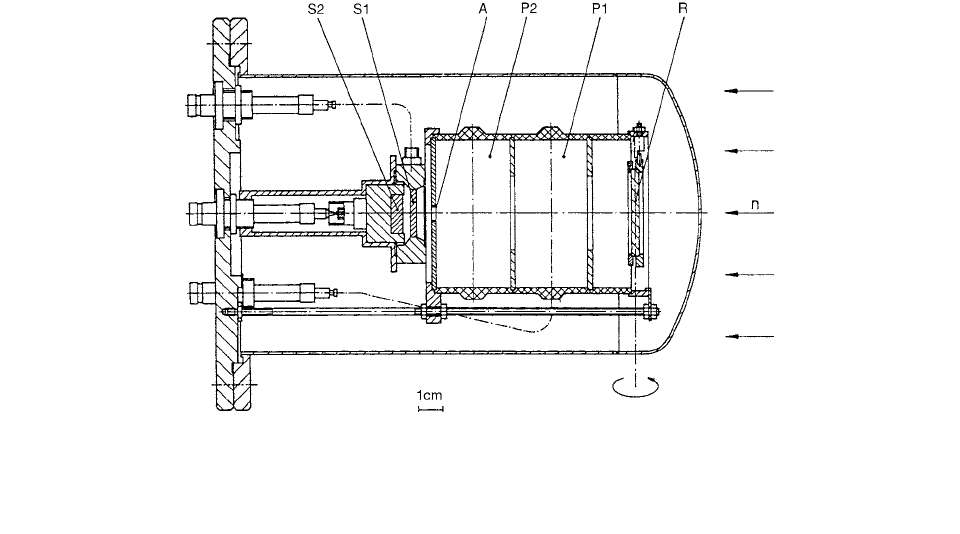
Neutron Dosimetry 427
Kerma factors for carbon and A-150 tissue-equivalent
plastic were determined by Schuhmacher et al. [2] in two
nearly monoenergetic neutron beams. Kerma was mea-
sured with low-pressure proportional counters (PC) with
walls made of graphite and A-150 plastic. The neutron
fluence was measured with a proton recoil telescope. The
corrections for the kerma contributions from low-energy
neutrons in the beams were determined by time-of-flight
measurements with an NE213 scintillation detector and
with the PCs. For neutron energy of (26.3 2.9)MeV and
(37.8 2.5)MeV, the kerma factors for carbon were (35.5
3.0)pGy cm
2
and (42.6 3.9)pGy cm
2
, respectively,
and for A-150 they were (75.6 5.4) pGy cm
2
and (79.0
5.6) pGy cm
2
. At these energies the kerma factor ratio
for ICRU muscle tissue to A-150, calculated on the basis
of the new kerma factors, is 0.93.
A proton recoil telescope (PRT) was used for the
fluence measurements; it was based on the detection of
recoil protons produced by elastic scattering in a hydro-
gen-containing radiator foil. This type of instrument
enables the neutron fluence to be determined with uncer-
tainties of only 2.5% to 3% in the neutron energy range
from about 1 to 15 MeV and is therefore used as a primary
fluence standard at various laboratories. The PRT
described by Schuhmacher et al. consisted of a polyeth-
ylene (PE) radiator foil (areal density 144.7 mg cm
2
)
mounted on a 1.0-mm thick Ta backing, two proportional
counters, a solid-angle defining aperture, and two solid
state detectors, and (Figure 10.4). The proportional
counters were filled with isobutane at a pressure of 50
kPa. A 1.0-mm-thick Si surface barrier detector was cho-
sen for
S at 27 MeV and a 2.5-mm-thick one at 39 MeV,
while in both cases consisted of a 5.0-mm -thick Si(Li)
detector operated at room temperature. For the 39-MeV
neutron field, a 0.5-mm-thick aluminum absorber was
inserted into the PRT between the aperture and S
1
, so that
protons of the maximum energy were stopped in the sili-
con detector . The signals from the four detectors were
analyzed with a multi-parameter data acquisition system
which allowed the protons to be discriminated from other
types of charged particles emitted from the radiator foil.
The PRT was used to determine the fluence of neu-
trons of the nominal energy, i.e., within the main peak.
The probability of energy depositions by recoil protons in
the various detectors of the PRT for a given spectral neu-
tron fluence at the position of the radiator was calculated
with a Monte Carlo program. It simulates the production
of recoil protons and their transport through the telescope,
including energy loss straggling and angle straggling. The
cross sections for
n-p scattering were based on experimen-
tal results published by Fink et al. [3] These data, which
were determined with total uncertainties of less than 2%,
are about 5% higher at 27 MeV and 10% higher at 39
MeV than those from a phase shift analysis for the scat-
tering angles which were observed with the PRT. The
phase shift was employed for interpolating the measured
data in energy and angle.
The tissue absorbed-dose determination depends upon
knowledge of the relative rate of charged-particle energy
production per unit mass for the tissue and tissue substitute
S
1
S
2
S
2
S
2
FIGURE 10.4 Schematic drawing of the PRT with radiator (R), “pillbox”-proportional counters ( and ), solid-angle defining
aperture (
A), and semiconductor detectors ( and ). The PRT is irradiated from the right. The radiator assembly consists (from
right to left) of a graphite disc, a Ta backing, and a PE disc. The assembly was turned by 180 degrees for the background measurement.
(From Reference [2]. With permission.)
P
1
P
2
S
1
S
2
Ch-10.fm Page 427 Friday, November 10, 2000 12:04 PM
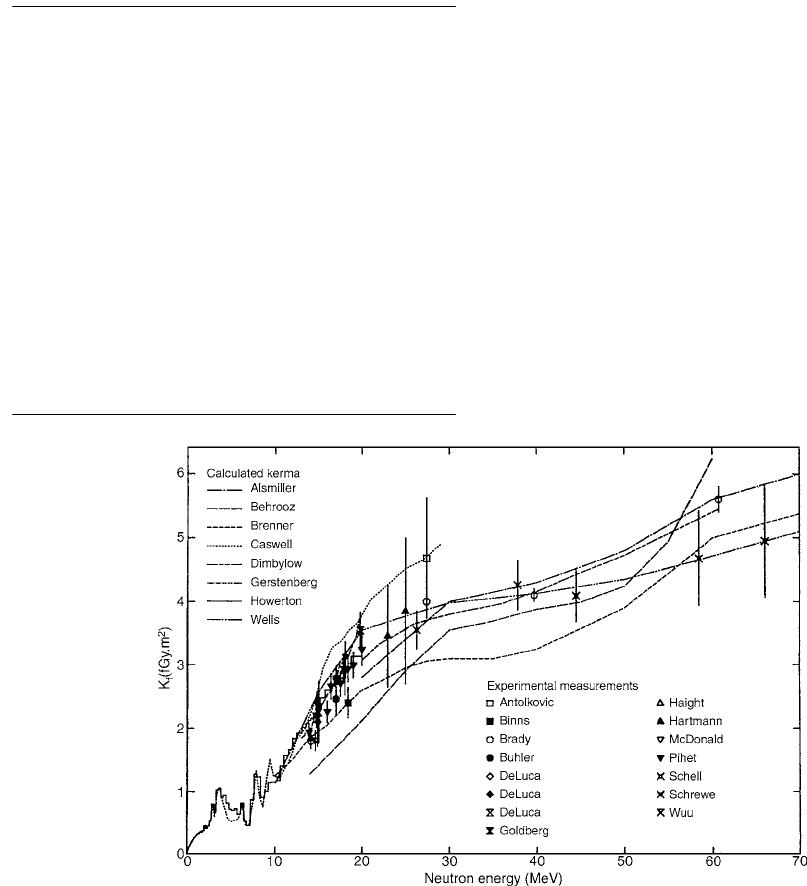
428 Radiation Dosimetry: Instrumentation and Methods
material, i.e., the kerma or kerma factor ratio. As the kerma
ratio is a function of the neutron energy, information about
the neutron energy spectrum is needed. Hence, neutron
dose determinations using tissue-substitute materials
require accurate kerma factor values for all constituent
materials for both the tissue and tissue substitute over the
entire neutron energy range. [4] Recommended hydrogen
kerma factors for neutron energies from 10 to 70 MeV
calculated from cross sections obtained from the “VL 40”
phase shift analysis are given in Table 10.1. Figure 10.5
shows the information known for both measured calculated
neutron kerma factors for carbon as a function of incident
neutron energy. Figure 10.6 shows a summary of measured
and calculated neutron kerma factors for oxygen as a
function of incident neutron energy. The experimental
database for oxygen is limited.
Modern neutron radiotherapy employs energies extend-
ing to 70 MeV, while industrial applications such as trans-
mutation and tritium breeding may generate neutrons
exceeding energies of 100 MeV. Secondary neutrons pro-
duced by advanced proton therapy facilities can have ener-
gies as high as 250 MeV. Evaluated nuclear data were
presented for C, N, and O by Chadwick et al. [5].
An important consequence of these microscopic
cross-section calculations is the determination of integral
radiation dosimetry quantities—kerma factors. Figure
10.7 shows total and ejected particle partial kerma factors
for C and O. Such detailed information is a direct result
of the inclusive modeling technique. Note that the proton
kerma increases rapidly with energy and exceeds that for
alpha particles at 50 MeV(C) and 42 MeV(O). Another
striking consequence is the contribution of deuterons,
which exceeds that for alpha particles at higher neutron
energies, reaching 25%(C) and 20%(O) of the total kerma
at 100 MeV. This rapid increase in proton and deuteron
kerma at higher energies due to pre-equilibrium mecha-
nisms was not recognized in the earlier extension to 32 MeV
of ENDF/B-VI.
Kerma factors of carbon and A-150 tissue-equivalent
plastic have been measured by Schrewe et al. [6] in nearly
monoenergetic neutron beams at energies between 45 and
66 MeV. The kerma was measured with low-pressure pro-
portional counters (PC), with the walls consisting either
of graphite or A-150 plastic material, and the neutron
beam fluence was measured with a proton recoil tele-
scope. The kerma factor corrections were determined from
TABLE 10.1
Recommended Neutron Kerma Factor
for Hydrogen.
E
n
(MeV) K
f
(fGy.m
2
)
10.00 45.69
12.38 46.59
15.62 46.93
20.46 46.50
31.42 44.21
46.19 41.11
59.79 38.92
70.00 37.80
The table is designed for linear-linear interpolation. The uncertainty
(1 standard deviation) is l% at all energies.
From Reference [4]. With permission.
FIGURE 10.5 Measured and calculated neutron kerma factors for carbon as a function of incident neutron energy from 0 to 70 MeV.
(From Reference [4]. With permission.)
Ch-10.fm Page 428 Friday, November 10, 2000 12:04 PM

Neutron Dosimetry 429
time-of-flight measurements with NE213 scintillation detec-
tors and PCs. At neutron energies of (44.5 2.6) MeV and
(66.0 3.0) MeV, the kerma factors were (40.9 4.1) pGy
cm
2
and (49.5 8.7) pGy cm
2
for carbon and (80.4 6.3)
pGy cm
2
and (80.1 8.2) pGy cm
2
for A-150 plastic.
The kerma K produced by monoenergetic neutrons of
energy E and fluence may be expressed as K(E)
, where is the kerma factor. Kerma factors may
be calculated from the cross sections as the sum
of the interactions of type j which produce charged parti-
cles of an average energy , multiplied by the number
of target atoms per unit mass n:
(10.10)
Above 20 MeV, however, calculations are much more
complex, since the number of reaction channels rises dras-
tically with increasing neutron energy, there is a lack of
precise cross-section data and the reaction kinematics are
scarcely known, particularly for the multi-particle breakup
reactions. Since kerma and absorbed dose are numerically
almost equal if the charged secondary particle achieves
equilibrium, the kerma was determined by measuring the
absorbed dose with a cavity chamber.
The total kerma obtained from the PC measure-
ment can be written as the sum of three portions: the
desired kerma of the nominal energy , which refers to
the neutron energy range to , and two background
contributions and . and are made accessible
by the two TOF measurements; is produced by neu-
trons of energy , and by .
The correction factor , defined as the ratio ,
can be expressed as:
(10.11)
where is directly obtained from the PC-TOP mea-
surements and is calculated from the spectral neu-
tron fluences and kerma factors extrapolated from recent
measurements and theoretical predictions. Although the
kerma fraction of low-energy neutrons, , was
quite substantial, was determined with a relatively low
uncertainty (see Table 10.2).
The ICRU has introduced the quantity Personal Dose
Equivalent, (see Chapter 1), as an estimator for the
effective dose, E, as the primary limiting quantity for all
conditions of penetrating radiation, i.e., radiation-type energy
and angle of incidence. It is defined as the dose equivalent
in 10 mm depth of an individual. The definition of Personal
Dose Equivalent, , does not lead to a unique value
because it depends on both the individual and the site chosen
in which to obtain . [7] For the purposes of devel-
opment, type testing, and calibration of individual dosime-
ters, the quantity was extended by the ISO to the TE slab
phantom. In this case has a unique value for a given
radiation field. It serves as some kind of “estimator for the
estimator” and shall be sufficiently conservative compared
with the effective dose, at least for an irradiation incidence
which is restricted to the frontal half-space. Monte Carlo
calculations were performed by Leuthold et al. [7] using the
MCNP code version 4A. This code is capable of transport-
ing neutrons and photons as well as electrons.
FIGURE 10.6 Measured and calculated neutron kerma factors for oxygen as a function of incident neutron energy from 0 to 70 MeV.
(From Reference [4]. With permission.)
k
f
E() k
f
j
E()
E
j
E()
k
f
K nE
j
E()
j
E()
j
K
tot
K
0
E
2
E
max
K
1
K
2
K
1
K
2
K
1
0 E
1
K
2
E
1
E
2
k
c
K
0
K
tot
k
c
K
0
K
tot
1 K
1
K
tot
()1 K
2
K
0
()
K
1
K
tot
K
2
K
0
1 k
c
()
k
c
H
p
10()
H
p
10()
H
p
10()
H
p
10()
Ch-10.fm Page 429 Friday, November 10, 2000 12:04 PM
